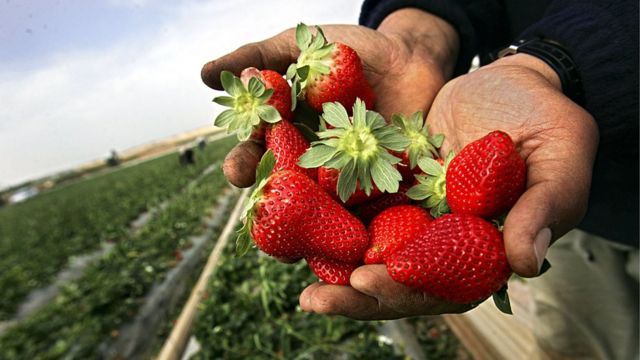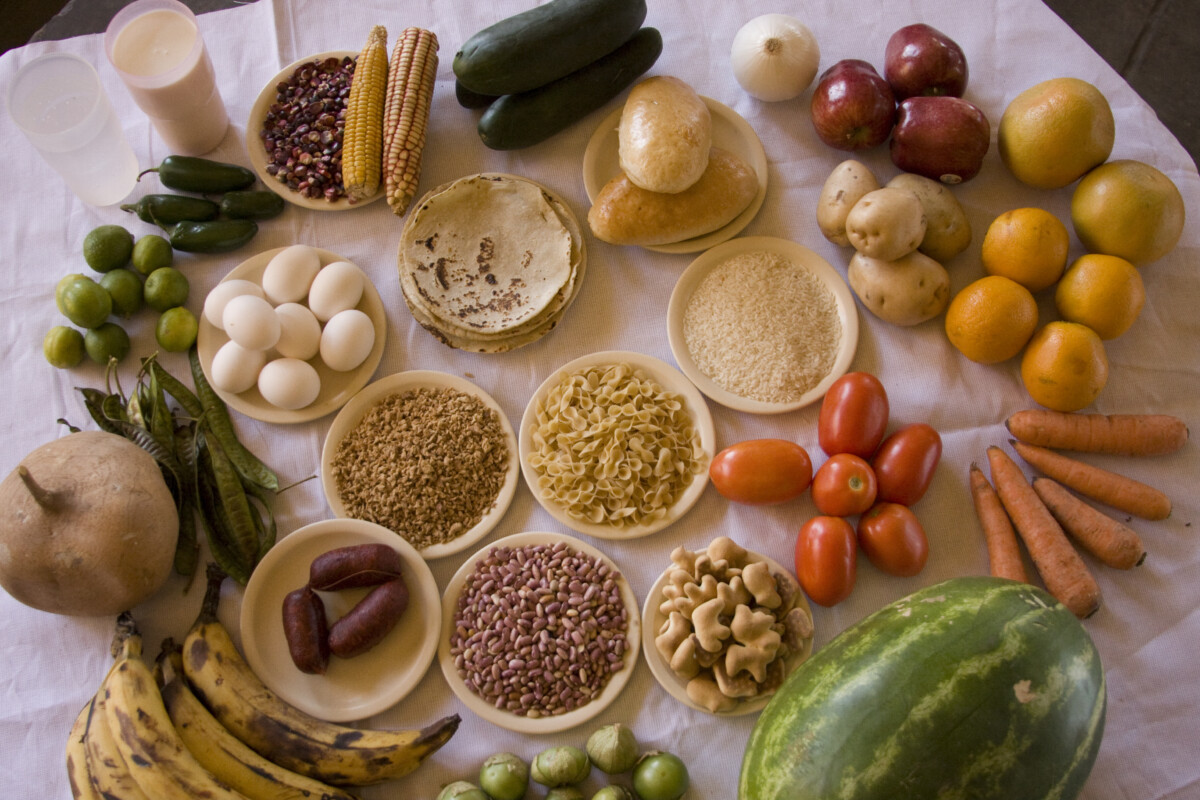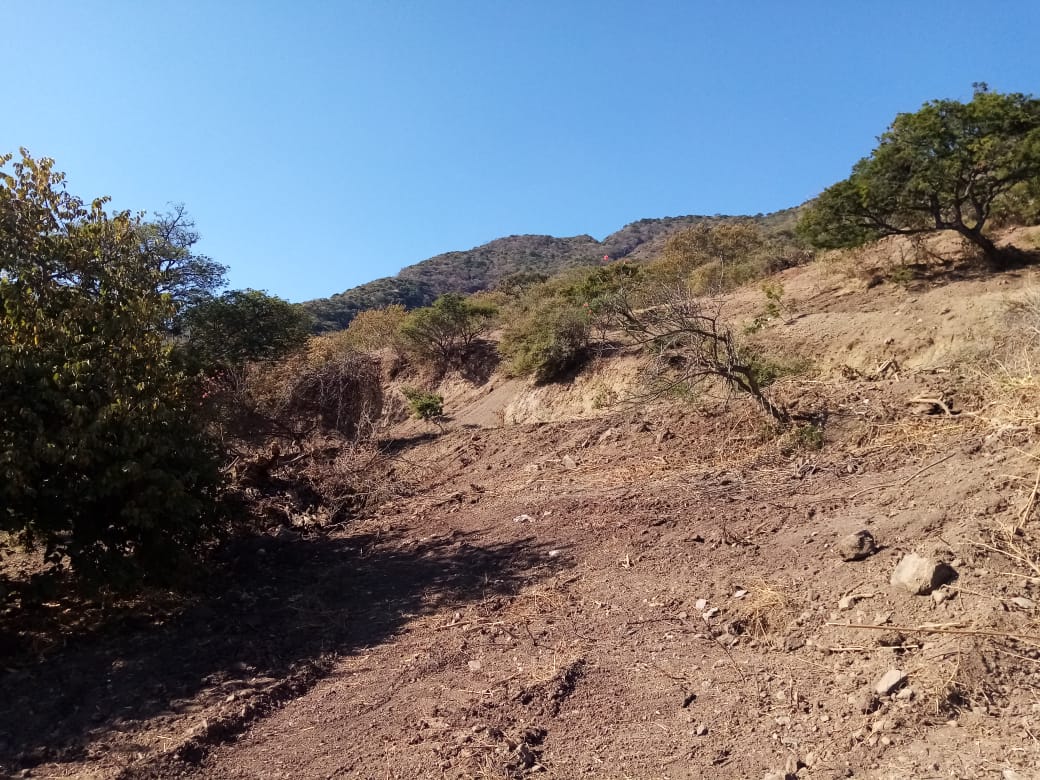en inglés
Jocotepec unites in adversity after the death of Pedro Isaac Aguilar Rentería
Photograph of Pedro Aguilar. Photo: Courtesy.
Héctor Ruiz Mejía – The death of Pedro Isaac Aguilar Rentería, an 18-year old who loved soccer has shocked and saddened Jocotepec.
“I never imagined how much people loved my son,» said José Francisco Aguilar, a native of the municipality of Jocotepec, who at 45 years old, never imagined the tragedy that he and his family would suffer.
However, in the face of adversity, the farewell that the people and his friends gave Pedro something has comforted the heart of his father Francisco. Pedro was known as «el cuatito» (because he was a twin) died January 1st after a serious accident . Friends of «el cuatito» said goodbye for the last time to their beloved friend to the beat of «Muchacho Alegre, remembering his life with joy.
To the surprise of his family, last Tuesday, January 4th, hundreds of people attended his funeral mass, for which his mother thanked the people of Jocotepec with the words: «Jocotepec is a very beautiful town, but when it shows unity for others, it is a beautiful town».
“I just asked them not to stop singing, and they did not stop singing; that gave me a lot of happiness, realizing how much people loved my son, he was like an artist who knew everyone,» recalled his father remembering the charisma that his son had in life and how he was a hard-working young man from a very young age.
“While finishing his acupuncture studies at the CETAC» he worked as a laborer on a construction site, and as a fruit vendor and a lot of other jobs; he never gave up work” said his father., recalling with deep feeling, his father the passion that the young man of 18 felt for soccer, saying «he was very good, he was always wanted to play».
“I try to stay strong, to stay serene and calm, but there are moments when I can’t stand it, I just can’t.» No father should bury his children,” said Francisco Aguilar who knows that he still has family to think about, which gives him some strength and courage to continue.
Translated by Patrick O’Heffernan
Tlaxcalans to help with berry harvesting in Jocotepec and Tapalpa
Harvested strawberries
Approximately 142 workers from the state of Tlaxcala will begin working in the fields of Jocotepec and Tapalpa to help with strawberry and raspberry picking, according to the State System for the Promotion of Employment and Community Development.
On December 14, the last group of day laborers from Tlaxcala left for Jalisco, after being requested by BerryMex, a company that produces and exports berries.
The hiring period will be nine months, during which the workers will be given free housing, although they will have to pay the rest of their living expenses for their stay.
BerryMex’s collective bargaining agreement provides for a salary of between six and 10 thousand pesos per month, free transportation to and from work, social security, a voucher for 350 pesos for the purchase of groceries upon arrival of the workers, as well as blankets and pillows.
The individual day worker’s salary will depend on their skills and experience, with the possibility of overtime pay.
Translated by Colleen Beery
Memories of Ajijic:
Nativity scene set up in Ajijic’s central plaza, in 2020.
Sofia Medeles (Ajijic, Jal.) – The Christmas festivities in Ajijic have not always been as they are now. According to the words of Ajijic historian, Eduardo Ramos Cordero (also known as Lalo) family dynamics have changed, as well as many of the long-standing traditions.
«Many years ago, the celebrations of Christmas Eve, and Christmas Day were different. On the 24th, the celebration was more religious. There was no big family dinner, families would go to mass (usually at midnight). After mass ended, they would go to the square, where a child (representing an angel) would place the figure of Jesus in the Nativity Scene. The creche was located in front of the Chapel of the Rosary. After that procession, there was a pastorela; everyone would enjoy themselves, and from there they would go to their homes,» commented Lalo.
He recalled that on Christmas Day people would gather in vacant lots and open spaces to get together and share a meal. Older women would get together to prepare «tamales de piedra,» also called mezcal tamales. These special tamales are made with beans (without salt). He added that the women used to meet at the houses of those who had an oven to cook, and make an exchange, for example, they would say to the one who had an oven, “let me cook in your oven and I will give you half of the tamales.”.
Also popular is red corn pinole,also called pinol or pinolillo, is roasted ground maize, mixed with a combination of cocoa, agave, cinnamon, chia seeds, vanilla, and/or other spices. The resulting powder is then used as a nutrient-dense ingredient to make different foods (cereals, baked goods, tortillas, and beverages). The name comes from the Nahuatl word pinolli, meaning cornmeal. Today, pinole is still made by hand using wood-burning adobe ovens, and a mortar and pestle.
In addition, Lalo shared one of the lost traditions of Ajijic, taking the Niño Dios (patron saint of the Tecoluta neighborhood), and making a procession from Río Zula to Six Corners. He commented that the procession included dancers from Ajijic, as well as from San Juan Cosalá. «In this procession, it was very nice to see the shepherds with their very tall canes (sometimes as tall as three or four stories), very beautiful, very well decorated, with bells, with colorful paper, and whatever else they had available. Also, it was one of the few times of the year when the children were allowed to eat candy. They were given a necklace with sweet tamales (called tuales), made with pinole.
The statue of the Child was then guarded for the rest of the year by a “godmother,” who was in charge of dressing him, and taking care of him until he was passed on to another family. He concluded by saying that sadly the Niño Dios de Tecolutla has been lost, and that the celebration was gradually discontinued. He said that he has hope that all these lost and emblematic traditions of Ajijic can be revived.
Translated by Amy Esperanto
ITEI requires Chapala and three other riverside municipalities to deliver information
During the 44th Session of the Institute’s Plenary on December 15, the municipalities were required to hand over the information.
Editor. – The municipalities of Chapala, Tizapán el Alto, Ocotlán and Degollado are being required by the Institute of Public Information and Data Protection of the State of Jalisco (ITEI) to turn over information that has not been satisfactorily provided.
In the case of Chapala, the Municipality must deliver information on the comings and goings of public servants from October 1 to 25 of this year. In addition, the Municipal System of Potable Water and Sewage (SIMAPA) must provide data on appointments, payroll and personnel of areas and headquarters that were dismissed.
In Tizapán, the agency asked for information regarding the agreements made in the first town council session, as well as the names of those who operate the municipality’s machinery. In Ocotlán, a copy of severance checks issued from October 2 to 16 was requested, and Degollado must complete the information of an injunction.
During the 44th Plenary Session of the Institute on December 15, four guides were approved: the Guide for the Protection of Privacy on the Internet, the Guide for exercising the Right of Opposition on the Internet (De-indexing), the Specialized Guide for the projection of resolutions aimed at the due integration in matters of Open Justice and the approach of inclusive language toward the population of Sexual Diversity, and the Guide for holders of personal data.
Also, corrective measures were imposed on the Green Ecologist Party of Mexico (PVEM) because of a complaint.
Translated by Mike Rogers
Eat Healthy this holiday season
Overconsumption of certain foods and beverages can cause colitis, gastritis and even pancreatitis.
Editor. As we gather with family and friends during the Christmas holidays our typical dishes are usually high in fat, salt and sugar. Nutritionist Alejandra Matias Serrano highlighted the need to be aware of the amount and frequency of food consumed during the holidays because overindulgence can affect health.
“During the holidays we tend to eat meats with high fat content, covered in rich sauces or gravies. We indulge in desserts, snacks and sweets. Our drinks are loaded with large amounts of sugar and fruit. We drink more alcohol. These excess calories can lead to a range of digestive problems ranging from gastritis (an inflammation of the stomach lining) and colitis (an inflammation of the colon. Overeating can result in higher glucose levels which can trigger diabetes as well as increased triglyceride and cholesterol levels which can affect the heart. The most common problem is weight gain,» said the nutritionist.
The expert shared research showing it is common to gain three to five kilograms during the Christmas holidays, adversely affecting those who already suffer from obesity and other chronic diseases.
Matias Serrano recommended modifying recipes, even of traditional dishes. We can make healthy versions without sacrificing flavor by reducing fats, selecting leaner meats, and increasing the quantity and variety of vegetables. Adding whole grains to our diet and reducing the sugar in our drinks are also ways to avoid those weight gains.
Be prepared for the temptations of the holiday season by eating fruits and raw vegetables before going to the festivities. Do not skip meals because you will be more tempted to overeat at that special dinner. Choose options with less visible fat, less cream or butter. A better choice is roasted, baked or grilled dish instead of fried, battered or breaded specialities. Control portion size. Stay hydrated by consuming six to eight glasses of plain water daily. Be physically active at least 30 minutes a day to offset the overindulgence.
«It is important that we enjoy the food we are going to eat. By taking time to savor the aroma, taste the food and eating slowly we will be more satiated. We are able to identify the moment when our stomach is full. Try to eat without distractions, without television, without the cell phone. Enjoy the moment,» said the official.
As a last piece of advice, Matías Serrano stressed the importance of serving moderate portions and using smaller plates.
Translate by Nita Rudy
Construction has begun on new subdivision in El Limón; fines not warranted
Although urban development reported only three trees felled, ecology reported the loss of more than 60 native trees. Photo: Courtesy.
Héctor Ruiz Mejía: The new development being built on El Limón hill, in San Juan Cosalá, a delegation that makes up the municipality of Jocotepec, does not have any type of permit issued.
According to José de Jesús Gaytán Cuevas, director of urban development in Jocotepec, the project, which is intended to be a new subdivision by a construction company named TAC, does not have a permit from said agency either.
«They have not presented themselves to our office, so the work has been stopped,» commented the director of urban development, who added that the construction company has taken the documents for review.
He said that the construction company will not be sanctioned and does not appear to deserve punishment, despite the fact that they had previously begun to build without any type of permit.
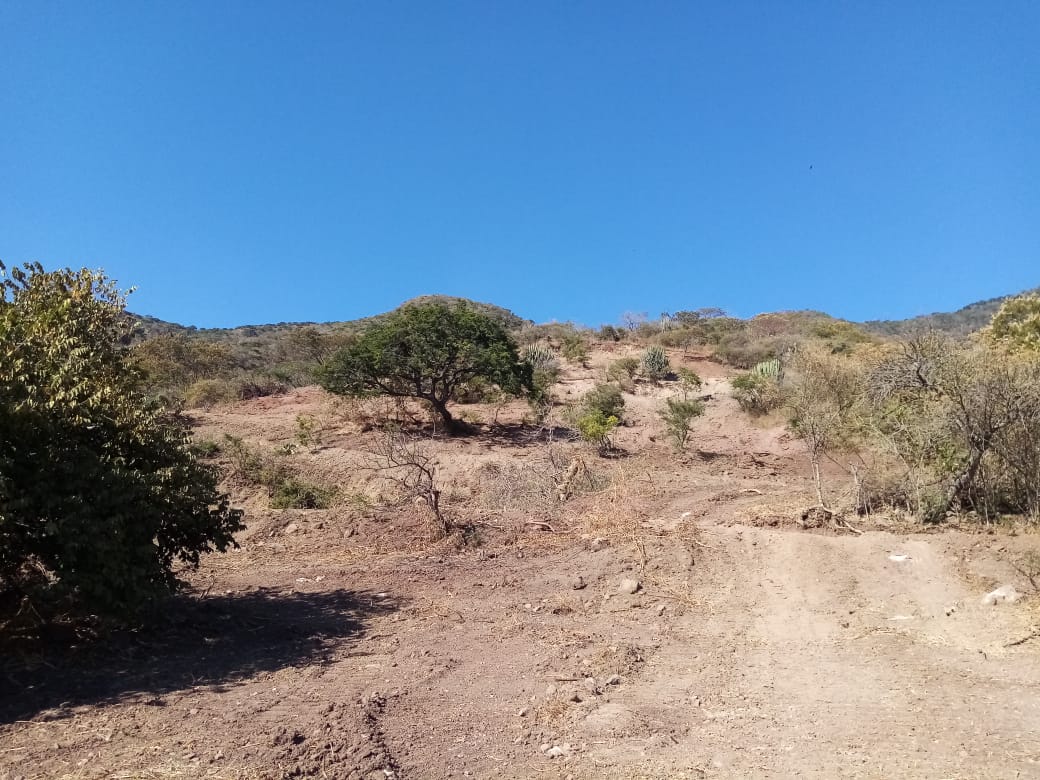
So far, the construction company TAC has not responded regarding the damage caused to the vegetation. Photo: Courtesy.
«No, they do not deserve any type of fine from us, they have already delivered their documentation and although they cannot work right now, we are already in review to determine the corresponding rulings,» he explained.
However, despite previous assurances by Jocotepec director of ecology Daniel Garabito that the construction company was deserving of fines for the felling of approximately 60 Palo Dulce native trees, Gaytán said that urban development only received reports of three trees cut down.
The private company has not responded to the summons to clarify what happened before ecology. However, according to Garabito, they are still waiting to reach some kind of agreement in which, at a minimum, reforestation work will be done.
So far, under the watchful gaze of the population, the next subdivision continues to go unpunished.
Translated by Kerry Watson
Fine-tuning the crosswalk on Colón Street
The malecon in Ajijic is where they expect the highest concentration of people.
Sofia Medeles (Ajijic, Jal.)- As part of the tourist operation in Ajijic for the Christmas holiday period the Head of the Delegado’s Office, Maximiliano Macias Arceo, will try to shorten the crosswalk on Colon Street.
He’d like it to start at the intersection with Ocampo instead of at the intersection with Parroquia Street, next to the main plaza. The purpose is to prevent obstructing traffic on the surrounding streets and to reduce inconvenience with parking.
Max also said that he wants to reduce the number of days he had originally proposed to start with the crosswalk which were December 20 until the New Year’s festivities. Now he thinks it would be more convenient to do it only on December 24, 25 and 31, as well as on January 1.
«This last week, due to the crosswalk to the plaza, there was a big disruption in traffic and parking. I will try to talk to the county president, Alejandro Aguirre, so that these days can be reduced,» said the mayor.
He added that, as part of the tourist operation in Ajijic, Civil Protection and Public Safety units will be making more rounds than usual in the downtown area and on the boardwalk where they expect the highest concentration of visitors, to ensure that everything is under control.
Children in Chapala show love of technology in their Christmas wishes
Today’s children prefer electronic gadgets or video games instead of strollers, dolls or traditional toys. Photo from Juguetón 2021.
Jazmín Stengel (Chapala)- Electronic devices such as cell phones, tablets and video games are the most desired gifts for children in the municipality this year.
In this sense, during the Juguetón 2021 (Toy Collection) in Chapala’s main square, many children took the opportunity not only to donate a gift, but also to share their Christmas wishes with Semanario Laguna.
Like 10-year-old Victor, who asked for a cell phone to share memes with his friends on social networks, or Sofia who wants a pink tablet because now dolls dress digitally by downloading fashion apps.
Video games have also become very popular among children and teenagers. A good example was Gabriel, who at 15 years old asked for the new “Halo” for Christmas and accessories for his latest generation “Xbox Series X.” Gabriel plays about 20 hours a week.
Of the approximately 10 children Semanario Laguna talked to last weekend, the wishes varied most in the brands or categories of the devices. The only difference was that clothing, makeup and fashion accessories reflect the desires of teenage girls.
It is now rare to hear a child ask for a bicycle or a skateboard, let alone spinning tops or marbles. Indeed, there were those who did not know the matatena (jacks). That was more so for the adults, who between jokes recalled the emblematic games of their childhood.
“We used to play ‘comidita,’ or jump rope,” recalled Isabel, mother of a girl and a boy who played in the plaza, while she and her husband took care of them. “The men played cops and robbers or wrestling,” the gentleman added to the conversation and concluded: “How curious! We millennials had to be in the middle.”
Translated by Mike Rogers
San Juan Cosalá celebrates 90th anniversary for the Virgin of Guadalupe
The statue of the Virgin of Guadalupe that is in San Juan Cosalá turned 90 years old this December 12. Photo: Héctor Ruiz
Héctor Ruiz Mejía: Three thousand worshipers gathered around the statue of the Virgin of Guadalupe in the procession held in San Juan Cosalá, in the municipality of Jocotepec. Fatigue did not set in for the faithful in the procession for the annual celebration of the Virgin, accompanied on foot, with the float that carried the statue in its journey through the lakeside delegation.
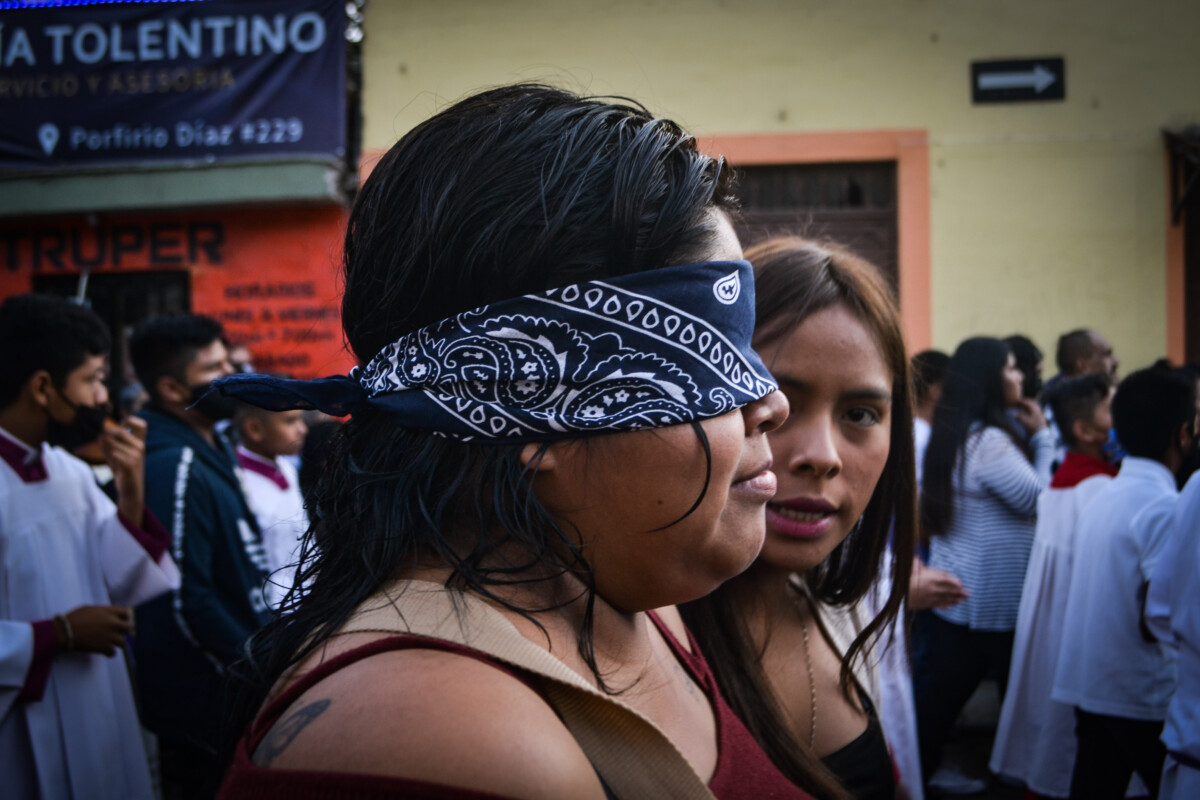
Many walk the procession barefoot and blindfolded in a ritual of the faithful. Photo: Héctor Ruiz
Many of the faithful even made the procession barefoot and blindfolded as a “manda” to ask favors to the iconic image, or as a sign of their unwavering affection. A “manda” is a promise or vow made by the faithful to ask for a miracle to help oneself or a loved one. In exchange for the miracle, the petitioner promises to fulfill the manda by making an offering or a sacrifice like those barefoot and blindfolded.
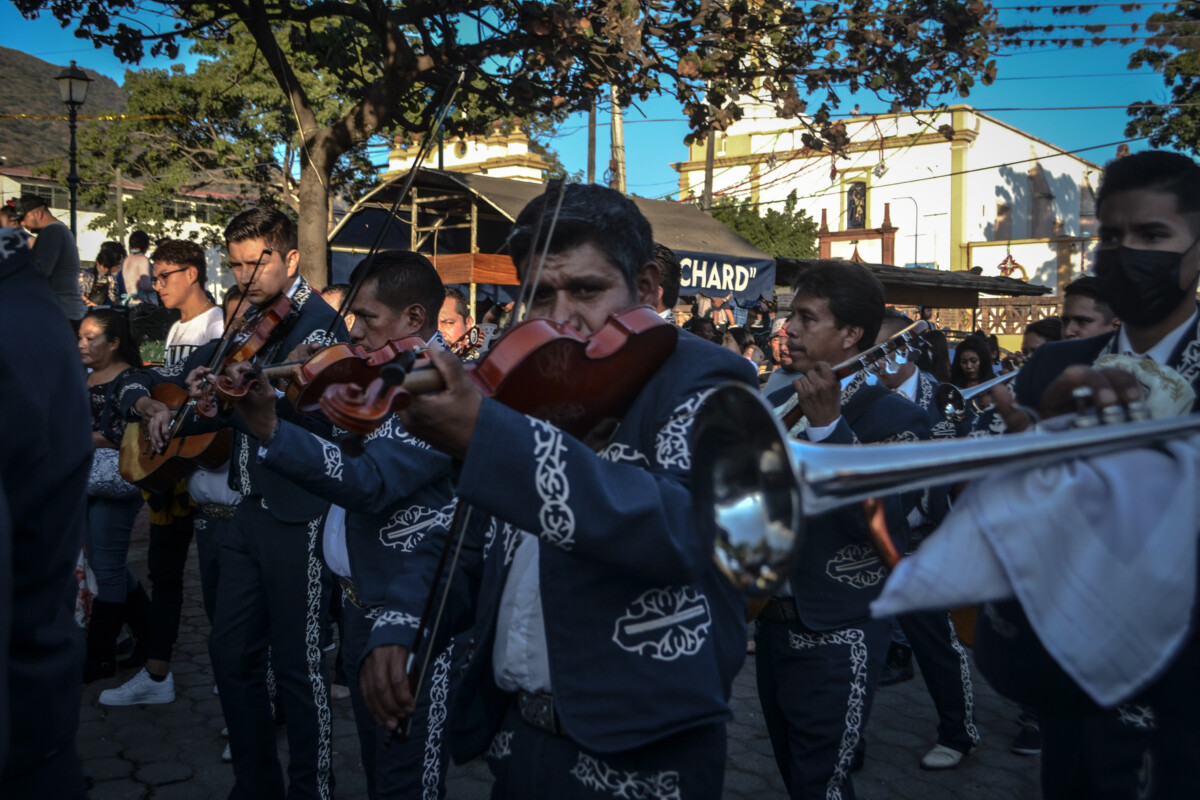
Mariachi Nuevo San Juan performing the mañanitas during the procession. Photo: Héctor Ruiz
«It is a tradition for people to make the procession barefoot and blindfolded for the manda, ever since the Virgin has been celebrated», explained the parish priest of the San Juan Bautista Church.
Thus, the 90th anniversary of the image of the Virgin of Tepeyac in San Juan Cosalá was commemorated to the music of ‘las mañanitas’ performed by the Mariachi Nuevo San Juan and the faithful who hoped, even for a brief moment, to get as close as possible to the statue.
This is one of the most important festivities not only for the country, but especially for the population of San Juan Cosalá, in which the Virgin has great religious relevance; «she is the woman who gave birth to Christ, the Mother of Our Savior,» commented one of the faithful who has been attending the procession all his life and reaffirmed his identity as a follower of the Virgin of Guadalupe or ‘Guadalupano.’
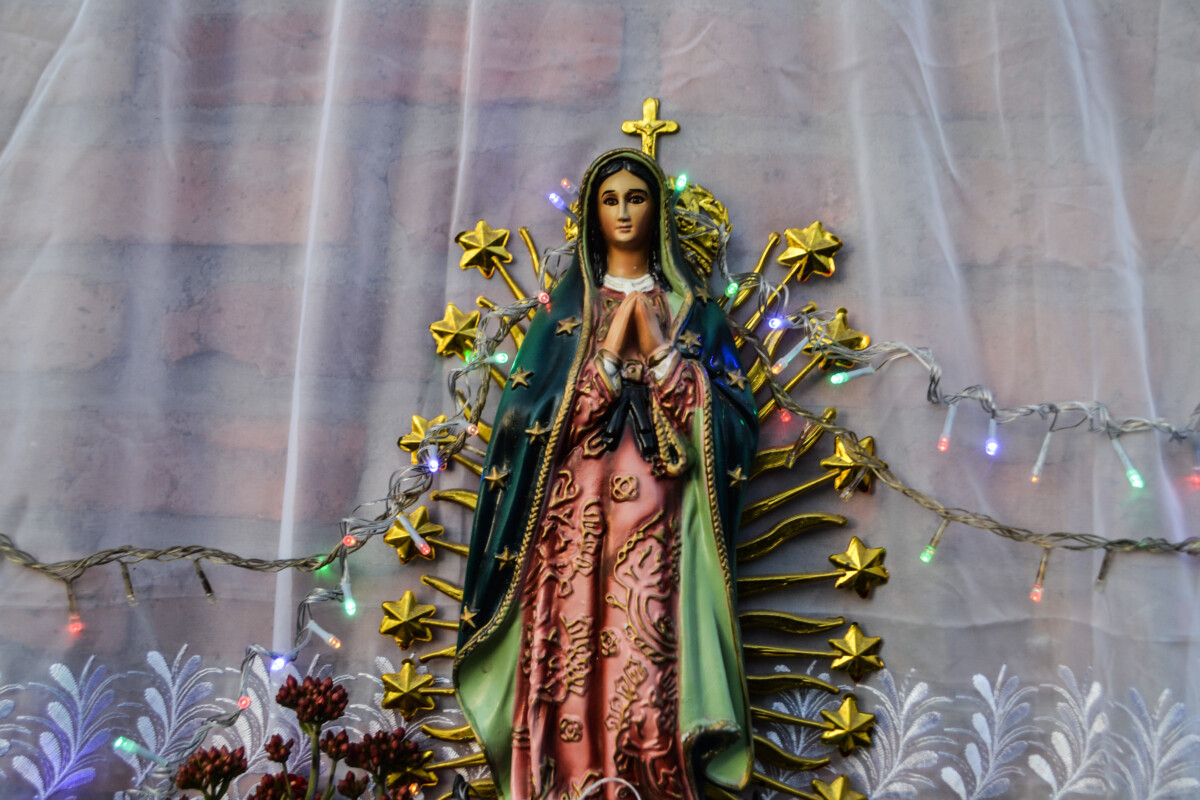
One of the several altars set up around Porfirio Díaz Street, alluding to the “Morenita” or Brown Virgin. Photo: Héctor Ruiz.
For one follower, Xochitl, it also represented a moment of hope, «since the pandemic we are going through a difficult economic situation, with many debts and other troubles. That is why I come today barefoot to ask the Virgin to give us the miracle to overcome these troubles», she explained while she was being led by the hand since she was blindfolded, and who had her feet hurt and covered with dirt from walking without shoes.
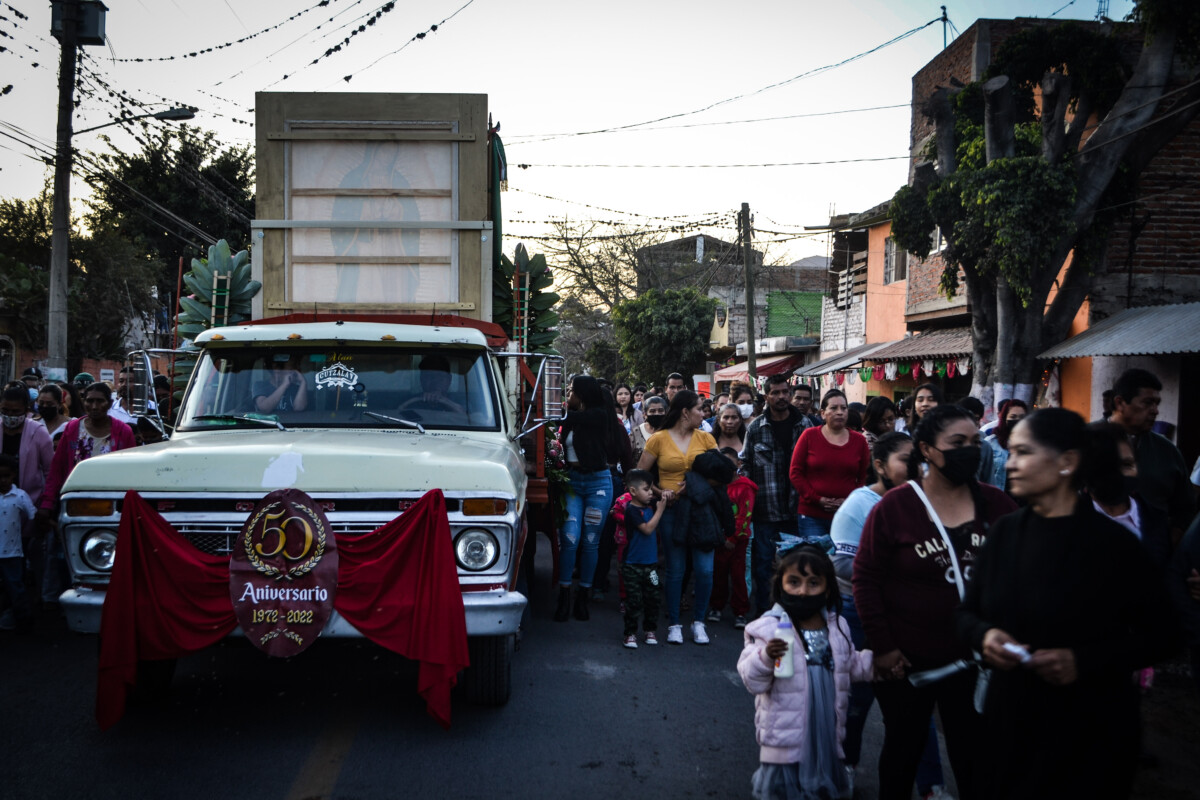
The faithful wait, if only for a brief moment, to approach the Virgin and touch her as she is transported on the float. Photo: Héctor Ruiz
Another of the faithful followers was Anita, whose bent body gave away her advanced age and despite this, wrapped in her shawl and holding a rosary with both hands, remained walking at all times at the Virgin’s side.
«Every year we have come here to celebrate the Virgin of Guadalupe, and we will be here as long as God allows us,» Anita said.
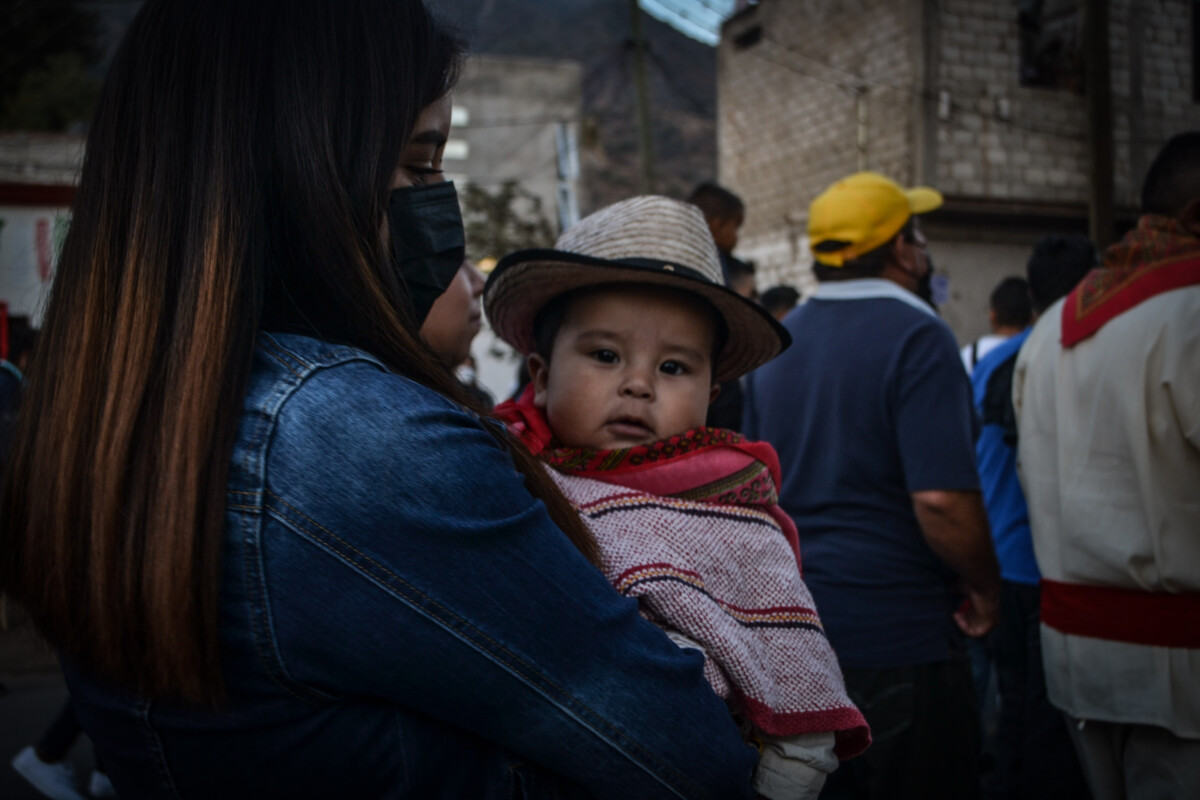
Little ones dressed as Juan Diego, Mexico’s first indigenous saint, accompanied the Virgin in the arms of their parents. Photo: Héctor Ruiz
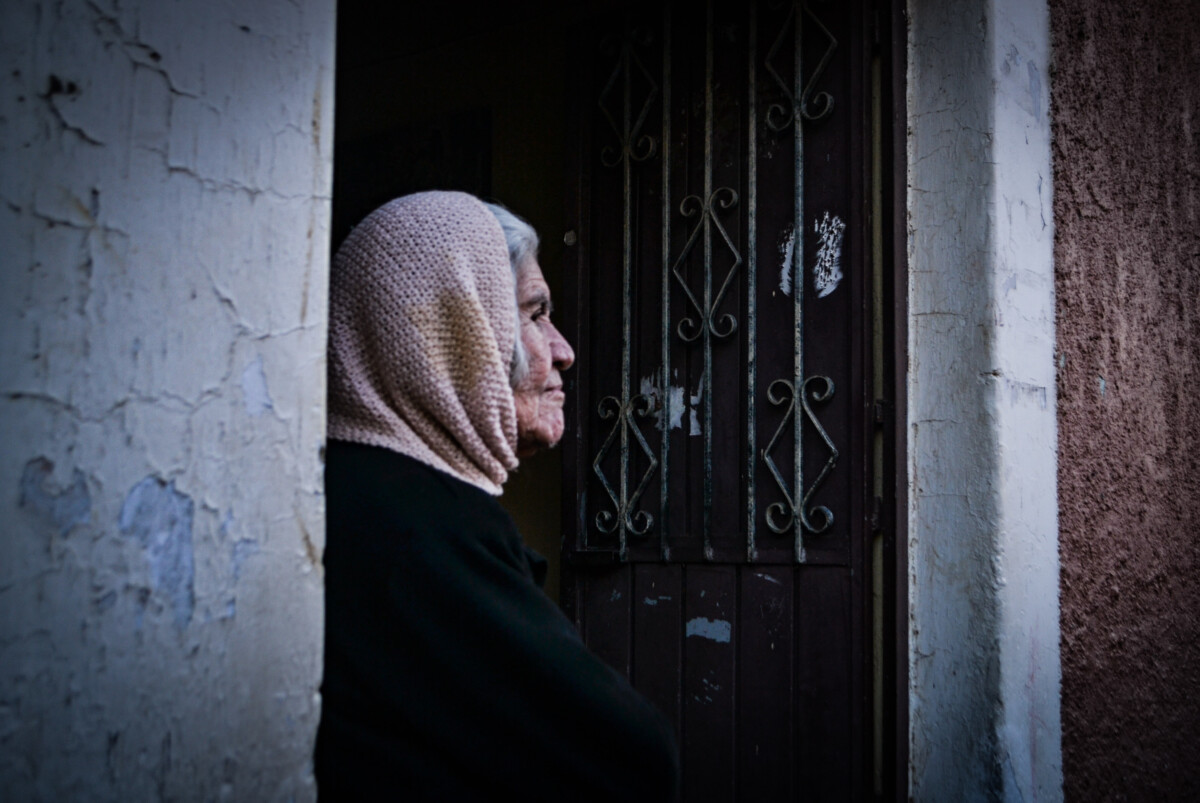
Woman observes, unmoving, as the Virgin passes by her house. Photo: Héctor Ruiz
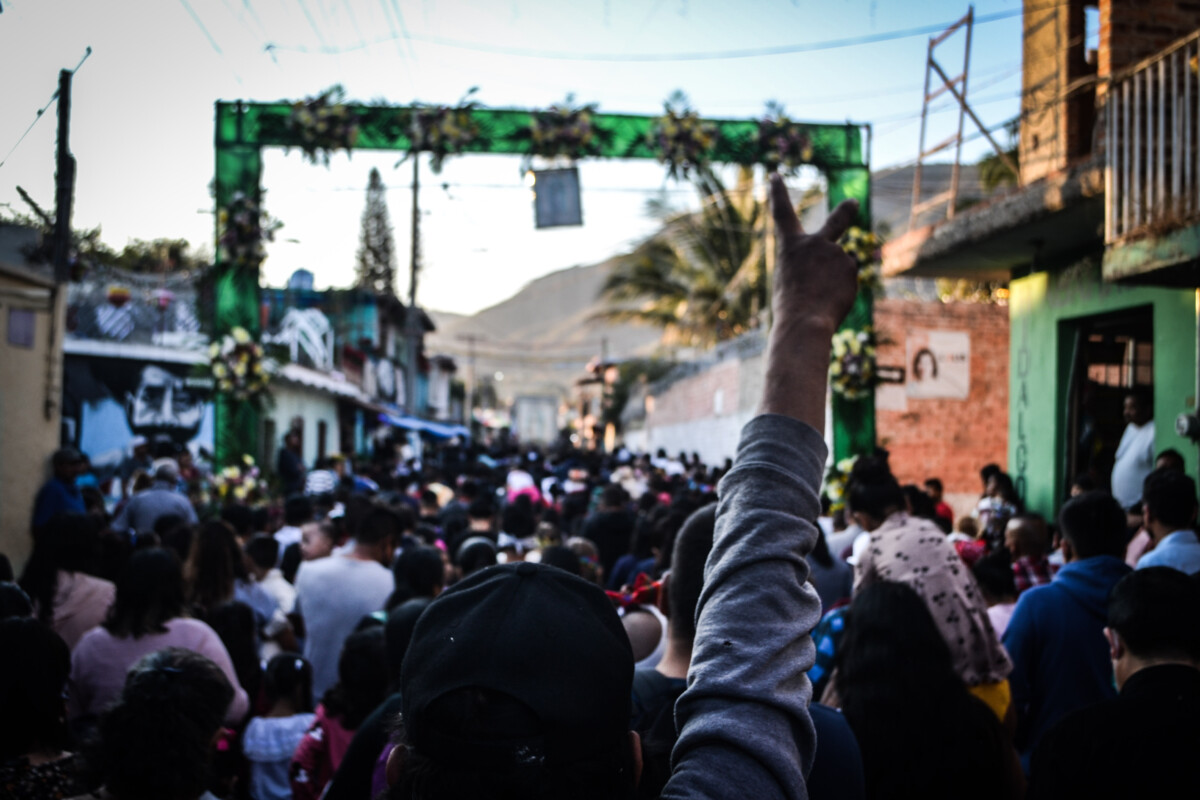
A sample of the joy felt by some of the faithful during the procession. Photo: Héctor Ruiz
Thus, the procession that began on the main street Porfirio Diaz and crossed the highway to return to the temple of San Juan Bautista, culminated with a huge mass in the atrium of the iconic church, where the faith of the believers was manifested in praises, songs, and applause.
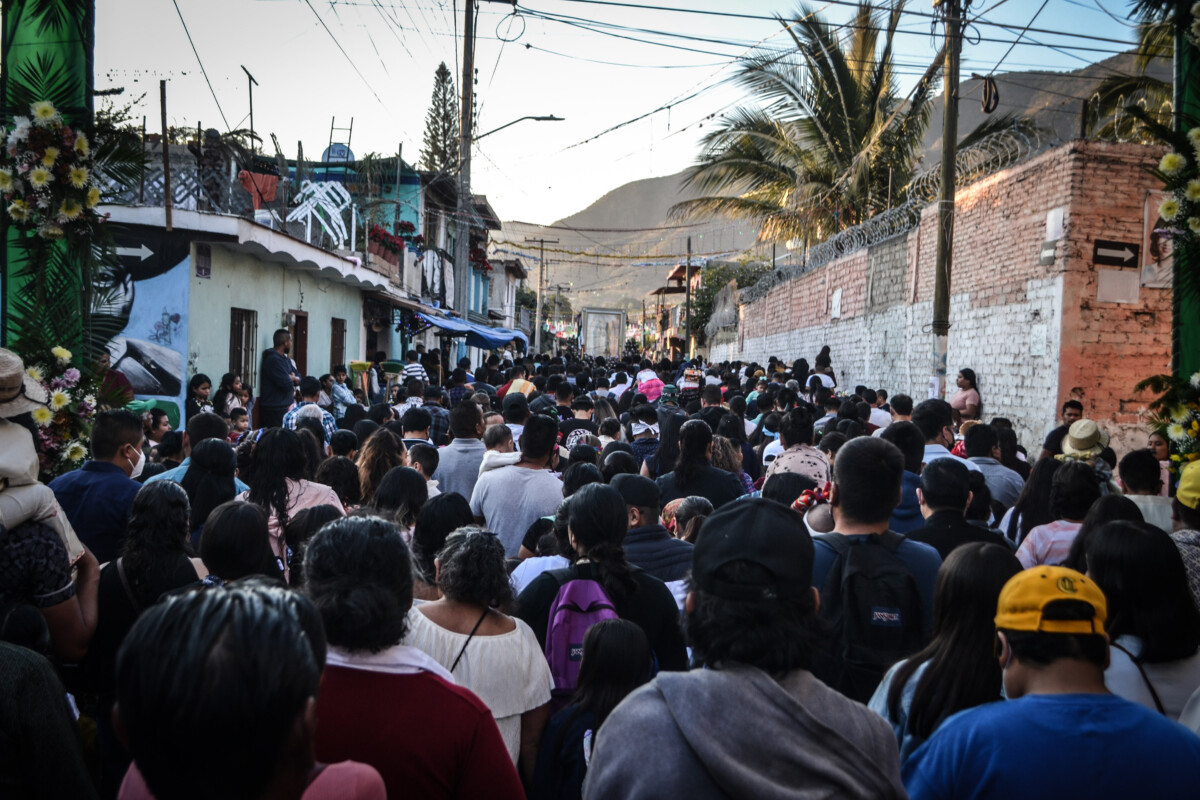
Around three thousand faithful attended the day of the Virgin of Guadalupe in San Juan Cosalá, in the municipality of Jocotepec. Photo: Héctor Ruiz
Translated by Kerry Watson
What is fitness? Part III
By Leticia Trejo
If you are following this opinion column you may notice that I was writing about Physical Wellness in Part I, then last week about Mental Wellness in Part II and this time we finish with Spiritual Wellness. They say in some traditions that we are like an onion, made of several layers and that at the core of these layers is the great gift of BEING. And why is BEING a gift? Because the being is a free entity, the being no longer feels suffering, has no attachments, has no burdens, simply IS, and when you reach that state you live in what is known as joy and fullness, this is Spiritual Well-being. It is intangible, but it exists.
Being spiritual or having spiritual well-being is not the same as being religious, as the Dalai Lama states in one of his beautiful phrases: “I believe that the only true religion consists in having a good heart.”
I firmly believe that the onion layers exist in each one of us and the famous psychologist Abraham Maslow (1908 New York – June 1970 Palo Alto, California) expressed it very well with the Pyramid where he proposes a hierarchy of human needs, without which we could not live an authentic spirituality. His approach, in order of need, was as follows:
Physiological needs (food, sex, sleep, etc.).
Need for safety and security (income, place to live, etc.).
Need for belonging (social connection, family, friends, etc.).
Need for esteem and recognition (affirmation of identity).
Need for self-fulfillment (transcendence, positive results of their efforts).
Because of this hierarchy, we began these columns with physical well-being. It is difficult to reach self-realization when our body is sick, weak and vulnerable. The same is true when it comes to mental well-being, which is one of the great obstacles to transcendence. A confused mind, full of fears and doubts, does not transcend. But why should we seek spiritual well-being? Precisely because it is one of the great goals of the human being and one of the only possible answers to the questions: what am I doing here, what is my purpose in this world? These are questions that most of us ask ourselves at some point in our lives, especially when we feel empty and incomplete and have no purpose. We also ask it when our thirst for more success, more money, more partners, more of everything does not fulfill us.
Victor Frankl’s wonderful book, “Man’s Search for Meaning,” unravels this mystery very well. Summarizing what is spiritual well-being we can affirm that: TO BE spiritual is to be authentically happy and capable of honestly practicing altruism and generously practicing solidarity. It is to feel real compassion for our fellow human beings and to see and treat ourselves and others with love.
This is an excellent time of the year to observe ourselves and recognize which of these basic needs we have met, which we have not, and perhaps discover what has prevented us from doing so. Hopefully we can dare to see those onion layers that keep us from reaching the Self and why we cannot experience Wellness in our lives (See the first column published on November 26, 2021: What is Wellness?).
Translated by Mike Rogers
© 2016. Todos los derechos reservados. Semanario de la Ribera de Chapala

